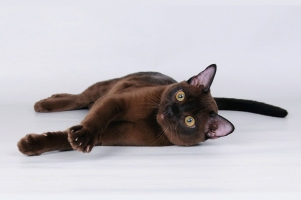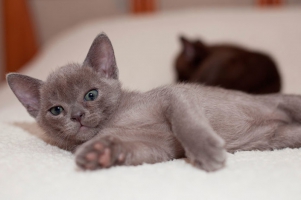About breed: Burmese
The history of the Burmese breed begins from the Wong Mau cat in the previous century.
In 1930 Dr Joseph Thompson brought the first representative of the breed in the US from Burma. He gave her the following description: a relatively small cat with quite a thin skeleton, a roundish broad-cheekboned head and big round eyes, with a more compact body and a shorter tail than that of a contemporary Siamese. The color of the hair was the most unusual being of a deep brown shade with dark-colored points. The type of Wong Mau was so extraordinary and differed from other existing breeds so much that Dr Thompson decided to create a new breed and got a group of experienced local felinologists and a team of scientists from the University of California with the head of Dr Keller involved into the breeding program. The authentic strictly scientific breeding program gave its early results soon, and in 1934 the first preliminary standard and first representatives of the breed with a third generation pedigree were shown to The Cat Fanciers´ Association (CFA) Committee on Breeds and Standards.
* In 1936 Burmese was given an official status by CFA. It has been a great success as the breeding itself began only in 1930.
* In 1947 CFA has adopted the resolution to register only those of the Burmese cats who had no less than three generations of pure Burmese parents (no hybridization with Siamese). It helped to save and to point the breed’s characteristics by competent line breeding.
*In 1949 Lillian France of Derby delivered three Burmese to England. A new breed has immediately attracted attention of breeders and fans. In 1955 The Burmese Cat Club was founded in England and in 1979 The Burmese Cat Society followed. To increase the population of the breed the breeders went on using the Siamese who differed in type from those Siamese originally used for breeding. In the result the Burmese bred in England and other European countries began to differ from their American equivalents.
* In 1952 the two biggest cat fanciers associations, The Governing Council of the Cat Fancy and The Cat Fanciers´ Association, adopted the Burmese cat standards which were not equal to the first standard approved by CFA.
Thus the two directions in cat breeding appeared: the appearance of American and European Burmese were so different that the European variant was sorted out as an independent breed named The European Burmese. It is forbidden by CFA to mix The American and The European Burmese.
Having conquered the hearts of cat fanciers in England and all over Europe, the Burmese got to Australia in the early 1950’s where they turned to become the most popular breed among the shorthaired. Australian breeders used American as well as European cats in their breed programs. As a result, the Australian Burmese became more thickset and heavy, their head more rounded and the whole look more circular. The final Australian Burmese type features were fixed in the breed standard adopted in 1970’s by The Australian Cat Federation, The Coordinating Cat Council of Australia and The New Zealand Cat Fancy.
In 1958 the United Burmese Cat Fanciers organization appeared. It exists till this day and takes an active part in the Burmese development and promotion. (http://www.united-burmese.org/)
In 1959 the CFA adopted a new Burmese standard developed by the United Burmese Cat Fanciers. Since then the standard has remained unchanged. It requires for a roundish head with a short nose, with round eyes and compact body. It was the first step that fixed the difference between the Burmese types.
The brown hair of the Burmese was first officially registered. The first standard of the Burmese brown color was adopted by The CFA. It was given a name of a Sable color as it looked very alike with the luxurious Siberian sable fur. In 1979 the CFA decides to sort out the blue, lilac and chocolate Burmese into an independent breed called Malayans. The breed existed in the CFA till 1984, and afterwards it was united with the Burmese again and composes a special division of clarified colors (Burmese Dilutes).
*At present The CFA has adopted 4 colors of Burmese hair. The same spectrum of the hair has been taken by the American Cat Fanciers Federation.
*The international Cat Association (TICA) recognizes a wider spectrum. In the breed selection the breeders of the association used the Siamese of red and cream colors as well as such rare colors as Cinnamon and fawn. Finally such colors as red, cream, cinnamon and faun and their tortoise shades have been added to the Burmese colors by TICA. To underline the unusual distribution of the color intensiveness, TICA has invented special term “sepia”. So, the brown Burmese color in TICA is called seal sepia, then blue sepia, lilac sepia and as follows.
*The European Burmese have their own colors including red, cream and tortoise. English breeders have introduced a red gene into the population in the middle of the 1960s and in 1977 the colors were registered by the Governing Council of the Cat Fancy in England.
*The common requirements for the Burmese colors in all the organizations are: no white spots or a number of white hairs in the fur or residual tabby points on the body, tail and paws. The exclusion here is red and cream colors where residual tabby markings on the body is not a considerable drawback. In these colors and in all colors of kittens less than 8 months faint tabby markings are allowed but penalized. After 8 months of age these markings are cause for disqualification in all but red and cream.
*Beside the differences in the color registration, there are nuances in the breed and standards registration itself. All the existing standards can be divided into two groups each of them describing a certain type. The first group is the standards for the American Burmese, the second –for the European. This division shows the morphological difference between the types as well as the history of the breed.
So, the Burmese breed is registered in the following felinological organizations, members of the World Cat Congress (WCC):
ACF (Australian Cat Federation)
FIFE (Federation Intrnatoinale Feline)
NZCF (New Zeland Cat Fancy)
TICA (The International Cat Association)
GCCF (Governing Council of the Cat Fancy)
SACC (Southrrn African Cat Council)
WCF (World Cat Federation)
CFA has registered two types: Burmese and European Burmese http://www.cfa.org/breeds.html
CCCA (Coordinating Cat Council of Australia) has also registered two types: Burmese and Burmese American). http://cccofa.asn.au/standard.htm
Each system has its own breed standards accordingly. Somehow they are similar, but have their distinctive features. Nevertheless, there are no other official divisions but those of organizations mentioned above and written on their homepages.
Thus the American Burmese is registered only in the Coordinating Cat Council of Australia (CCCA) standard. In other cases, they call American Burmese each cat that has the pedigree of the American type registered in CFA, TICA and ACFA and corresponds to the standards, proscribed in these associations.
The existing division of the American type to Contemporary and Traditional is relative and is accepted only among breeders. The registering organizations don’t distinguish between the subtypes. The judge only follows the standard of the system on the show where he works.
The Burmese strike not only by their unusual look and a charming character but also by their diversity. We can see from the breed history that it was formed and developed in different periods and on different continents, it followed various programs of felinological systems. Many of the Burmese features were formed historically; some of them were defined conventionally by the breeders. In any case, each direction in the type development deserves attention and respect. And it is not very correct to name the Burmese, which appeared in the result of outcrossing of some breed lines, mixed as they have only Burmese cats in the pedigree. And we can speak about the difference in the types within the felinological system of CFA only, where they have 2 Burmese standard (Burmese and European Burmese). Or the Australian СССА (two standards also), but for us it is not that urgent. CFA does not let the outcrossing of the types. Other European and American felinological organizations have only one standard for one type – Burmese. To make it short, the main difference in the standards is in the description of the head of the animal. But other than that the Burmese is described as an average cat with well-developed muscular system (the brick wrapped with silk) and with the unique silk hair which fits close to the body.
The color disqualifying features are the same for all standards. FIFe permits green eyes, yellow in other case. Click HERE (STANDARDS) to learn more about the systems and their standards.
If we go back to the history of the breed, it will become obvious that the population of the Burmese was never high. In 11 years it was forbidden to deliver the outcrossing with other breeds after the Burmese got a status of an independent breed in America. This helped to preserve the breed purity but lessened the list of animals good for breeding programs. In Europe there was no big opportunity to import the Burmese for selection, so, other breeds were used in the programs for a long time. It resulted in a huge number of hair colors that differed from the primary American variant. Each organization was fixing its own type in its standards. But the breeders everywhere faced the only problem – the small number of the breed representatives in spite of its popularity. Almost all the animals limited geographically, were related to one another. Here the inbreeding not only fixed the desirable features but preserved the defects. The introduction of new genes was the only way out.
We don’t know exactly when first Burmese appeared in the post-soviet region. It is supposed to appear in the Ukraine and the Baltic States first (1994-1997). It was the European Burmese. Their pedigree included Finnish, Dutch and Swedish catteries. Later the Burmese of European type appeared in Moscow. In Minsk the first cat came from the Ukraine in 2000. In 1998 a contemporary Burmese (HILLTOWN´S MARITN OF ALDIS) was imported from the US to Moscow. It was brought by Elena and Andrey Surinovs and gave a start to the glorious journey of the Burmese at shows and competitions in the former USSR republics.
Such cats were used for the outcrossing with the animals from other lines. In particular, first classic mixes with 50x50 American and European genes come from Martin.
Even then the breeders were trying to improve the type that was getting old at the time. They were trying to get the kittens that were closer to the American type, so to say, more round and stout ones. The first litters were quite miscellaneous. But afterwards, if the pair was chosen well, the breeds appeared to be more homogenous. Moreover, some animals were brought from Moscow and the US; and they were bred with Martin’s children and grandchildren. But as the lines differed by their origin, the results of the programs differed on the regional principle.
The interest to the breed grew much at that time. Since 2000 the Burmese were constant participants of the European cat shows, and they often won first prizes.
The import of the animals was a difficult thing at that period. Foreign breeders did not trust new Russian felinology and were not much eager to share their breeding material. In general, the so called mixed animals were shown according to WCF and FIFe systems as well as the breeds were registered. As it was already mentioned, these organizations do not distinguish between the types of the breed and let the outcrosing of the cats of different origin within the breed.
The breeders from Eastern Europe found those systems very popular and based their work on them. As the shows were held quite often and the Burmese actively participated in contests, the breed became recognized by the jury and admired by the audience.
While those breeders who were for pure lines (before Wong Mau) were arguing about the legitimacy of the lines crossing, mixed Burmese owners participated in the shows and won the rings in various cities. It’s due to the mixed types that represented the breed during 10 years at contests, the interest and affection for the breed has been saved. If it didn’t happen, the breeders would probably spend 3-5 years for the breed promotion. Moreover, the missed animals proved able to preserve and fix many of the natural features of the breed that were lost by “pure” representatives, e.g. the hear color and structure, eye color, the size and character. Thoroughly planned breeding programs, unique for each cattery, helped to get the animals that were able to adequately represent the breed at shows organized by TICA and CFA. This fact has is believed to give birth to certain hostility and contempt towards mixed Burmese. It seems to us a bit senseless to reject the type that has got such a potential for the breed development.
We should pay special attention to European Burmese type and the history of its adoption. Its formation was held on different continents and various animals were used. It made the phenotype diverse. Each felinological organization adopted its own standard in regards of its own breeding programs and its population.
In early 1990s the international CFA branch representatives paid attention to the fact that there were not many Burmese participate at CFA European shows. The breeders did not show them as there was a vast difference in American and European (FIFe) types. In June 1993 at the CFA administration meeting it was proposed to recognize those European Burmese that proved FIFe, GCCF (Great Britain) and ACA (Australia) standards. The decision was to promote CFA in Europe. The FIFe standard Burmese were called Foreign Burmese at the time.
At the next meeting of the CFA authorities in October 1993 Bill Lee (the CFA judge) offered to give The Eastern Burmese the championship status in the international division and non-championship one in the USA since May, 1994. The offer was accepted. Kim Everett (the CFA judge) offered to change the name of the breed to “The European Burmese”, which was also approved. It was necessary to develop the standard for the European Burmese in CFA. Wane Trevathan was delegated to prepare the standard on the basis of the FIFe, GCCF and Australian standards.
Since May, 1994 till April 2000 the European Burmese participated in the CFA exhibitions in the class of Miscellaneous. In this class the judges estimated the cats, but didn’t give them ribbons and places.
The next step was the recognition of the European Burmese as a Provisional breed. Such an inquiry can be made to the CFA executive committee after no less than 100 cats of a new breed took part in the exhibitions over 5 years, meanwhile there should be no less than 25 active breeders.
In February 2000 at the meeting of the CFA authorities the breeders of the European Burmese made a request for giving the breed a new status, which was approved by the governing.
Now the cats of this breed could participate in the exhibitions in the class Provisional (since May, 2000), though the status was non-championship. The judges estimated the cats and gave them places as in the championship class, but they didn’t give titles and the cats weren’t nominated for the final. The judges also filled the evaluation list for the clarification of the cats quality, if they meet the standards and so on. These lists were sent to the CFA office and later they were used making a decision on giving the breed an championship status. Now it was enough that 25 different cats took part in the exhibitions of all CFA regions and then the breed got an championship status.
In February 2002 the CFA Board Directors took a long-expected decision for the breeders of the European Burmese on giving the breed of the European Burmese an championship status in the USA since May, 2002.
Due to this decision the representatives of the two wonderful breeds: Burmese and the European Burmese adorn the CFA exhibitions today.
About breed: Burmese. Alla Levina.
Programming - Webstudio73.com











